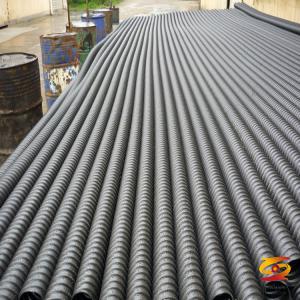corrugated pipe (PA, PE, PP) three raw materials performance difference analysis
corrugated pipe (PA, PE, PP) three raw materials performance difference analysiscorrugated pipe (PA, PE, PP) are widely used in the connection of machine tool machinery and electrical box control cabinets, and are equipped with plastic quick connectors. The company's product specifications are complete, with black and gray colors and natural colors. The products are beautiful, light, and durable. They are widely used in automotive wiring harnesses, electronics, and mechanical wiring harnesses. They have replaced the original PVC and metal sheath products and become widely used in the market. Wire harness jacket products.
The wire harness corrugated pipe we use is generally used in construction machinery and automobile wire harnesses to protect the wire sheath from scratches. It has low cost and easy operation. There are PP, nylon, PE and other materials. Generally, we distinguish different specifications by diameter (inner diameter, excluding wall thickness), such as ∮7.0 (inner diameter 7.0mm), ∮10.0 (inner diameter 10.0mm).
corrugated pipe can be divided into PA6 bellows, PP bellows, PE bellows. There are differences in the physical and chemical properties of the three raw materials PA6, PP, and PE. The following is a brief introduction on the performance differences of the three raw materials and how to distinguish them.
corrugated pipe
1. Performance difference of PA6, PP, PE raw materials:
Material Physical properties Advantages Disadvantages
PA6 is wear-resistant, high-strength, good toughness, self-lubricating, can be used for a long time at -40 ~ 100 ℃. The large water absorption makes the product size change greatly, and it should be dried in hot air before molding. Good mechanical strength, impact resistance, wear resistance, self-lubrication, high softening point, heat resistance, low friction coefficient, shock absorption and noise reduction, oil resistance, resistance to weak acids, alkalis and general solvents, good electrical insulation, good weather resistance , Easy to dye. High hygroscopicity, dimensional accuracy changes in long-term use.
PP has particularly high bending fatigue strength and good heat resistance. It can only reach -15 ℃ at low temperature, and brittle at low -35 ℃. Easy to age and not absorb water (high frequency insulation performance is good). Melting temperature: 220 ~ 275 ℃. It has good bending resistance and is called "100-fold glue". It will not become white after being bent in 1 million times. Can be used for a long time in boiling water. Large shrinkage, insufficient rigidity, aging and cracking under sunlight, and low temperature resistance.
PE has good chemical resistance, strong low temperature resistance, and a brittleness temperature of up to -70 ° C; good moisture resistance and electrical insulation. Good fluidity, easy color matching, good insulation, wear resistance, impermeability, chemical resistance, low temperature resistance, non-toxic, odorless, and low density. Not resistant to sudden temperature changes, low mechanical strength.
2. The method of distinguishing three types of bellows:
The combustion test identification method is usually used to distinguish the bellows of the three materials. The combustion test identification method uses a small fire to burn the plastic sample, observe the flammability of the plastic in the fire and outside the fire, and pay attention to the falling of the molten plastic after the flame is turned off. The method of identifying the type of plastic by the drop form and smell. The specific burning phenomena of the three materials are as follows:
Material name Burning status Burning flame status After fire separation Odor
PE is easy to melt and drip, yellow and blue continue to burn, paraffin burning smell
PP is easy to melt and drip, yellow and blue, a small amount of black smoke, continue to burn petroleum flavor
PA slow melt dripping foaming and slowly extinguish special wool, nail odor








